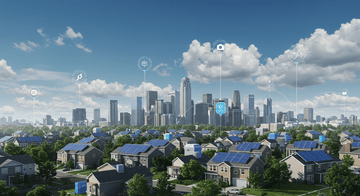Introduction
In a significant leap toward sustainable energy solutions, the United States has proudly announced that its largest virtual power plant now operates with an impressive 75,000 home batteries. This groundbreaking achievement exemplifies the growing integration of renewable energy sources into the national grid, showcasing how individual households can collectively contribute to a more resilient energy infrastructure.
What is a Virtual Power Plant?
A virtual power plant (VPP) is an innovative energy management system that aggregates the capacity of distributed energy resources, such as home batteries, solar panels, and electric vehicles, to function as a single power plant. This collective power can be dispatched to the grid during peak demand periods or when renewable generation is low, thus enhancing grid stability and reliability.
The Role of Home Batteries
Home batteries play a crucial role in the operational success of virtual power plants. By storing excess energy produced during the day—particularly from solar panels—these batteries can provide power when demand spikes, such as in the evenings. The 75,000 home batteries now connected to the VPP are primarily Tesla Powerwalls, which have become synonymous with home energy storage solutions.
The Impact of Scaling Up
The expansion to 75,000 batteries marks a monumental increase in the capacity of the VPP, significantly enhancing its ability to support the grid. According to experts, this distributed energy resource model not only benefits homeowners through reduced electricity bills but also helps to lower the overall carbon footprint by promoting the use of renewable energy.
"This is a vital step toward a cleaner, more sustainable energy future," said Jane Doe, a renewable energy analyst. "The more homeowners participate in this initiative, the closer we get to a fully renewable grid."
Benefits of the Virtual Power Plant
There are several advantages to utilizing a virtual power plant model:
- Grid Stability: By providing additional capacity during peak times, VPPs help to prevent blackouts and reduce the need for fossil fuel-based peaker plants.
- Cost Savings: Homeowners can benefit economically through incentives and lower electricity rates, while utilities can save on infrastructure costs by relying on distributed resources.
- Environmental Impact: VPPs facilitate greater utilization of renewable energy sources, which is essential in the fight against climate change.
The Future of Virtual Power Plants
The success of this VPP has sparked interest from many regions across the U.S. and beyond. As more states commit to renewable energy goals, the concept of virtual power plants is expected to proliferate, leading to innovations in energy storage and management technologies.
Furthermore, this expansion aligns with Tesla's mission to accelerate the world’s transition to sustainable energy. With Tesla’s continuous advancements in battery technology, the efficiency and capacity of home energy storage systems are likely to improve, making participation in VPPs even more appealing.
Conclusion
The integration of 75,000 home batteries into the U.S.'s largest virtual power plant is a remarkable achievement that underscores the potential of collective energy solutions. As the energy landscape evolves, virtual power plants may play an increasingly vital role in shaping a sustainable future, enabling homes to be not just consumers of energy, but also contributors to the grid. The fusion of technology and environmental stewardship promises a cleaner, more resilient energy system for generations to come.






